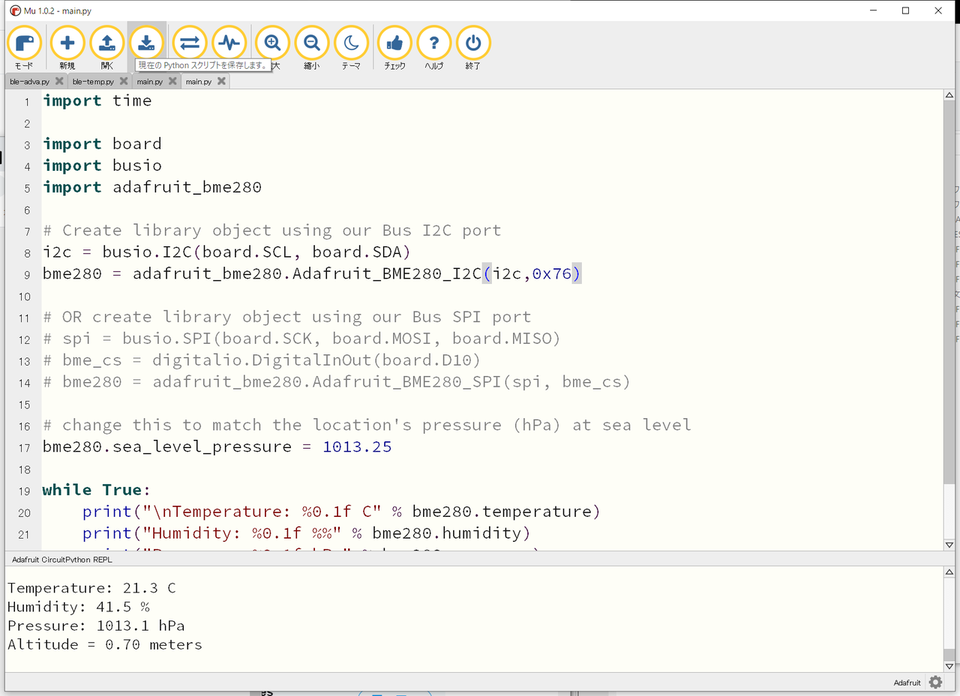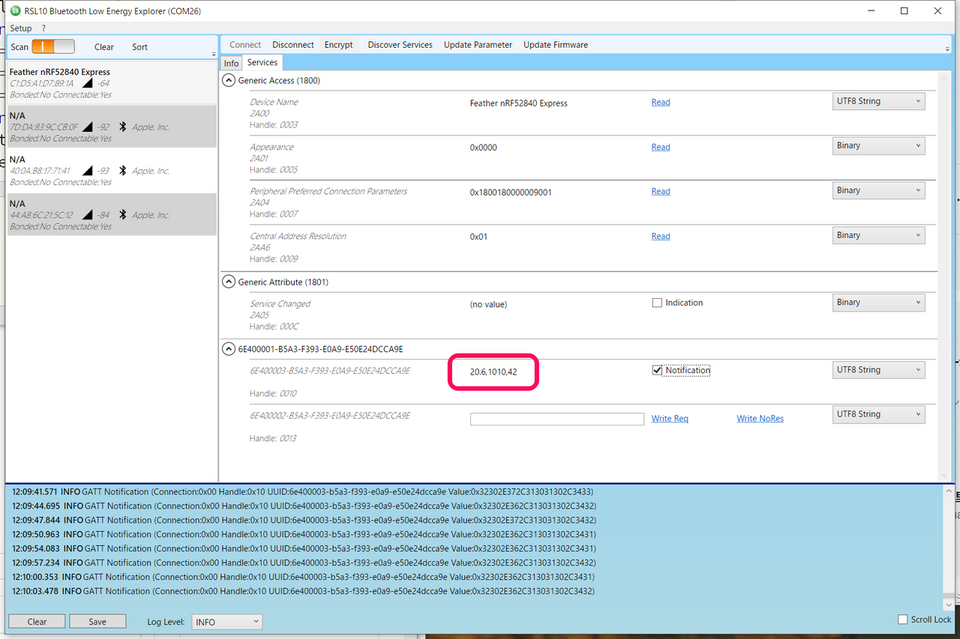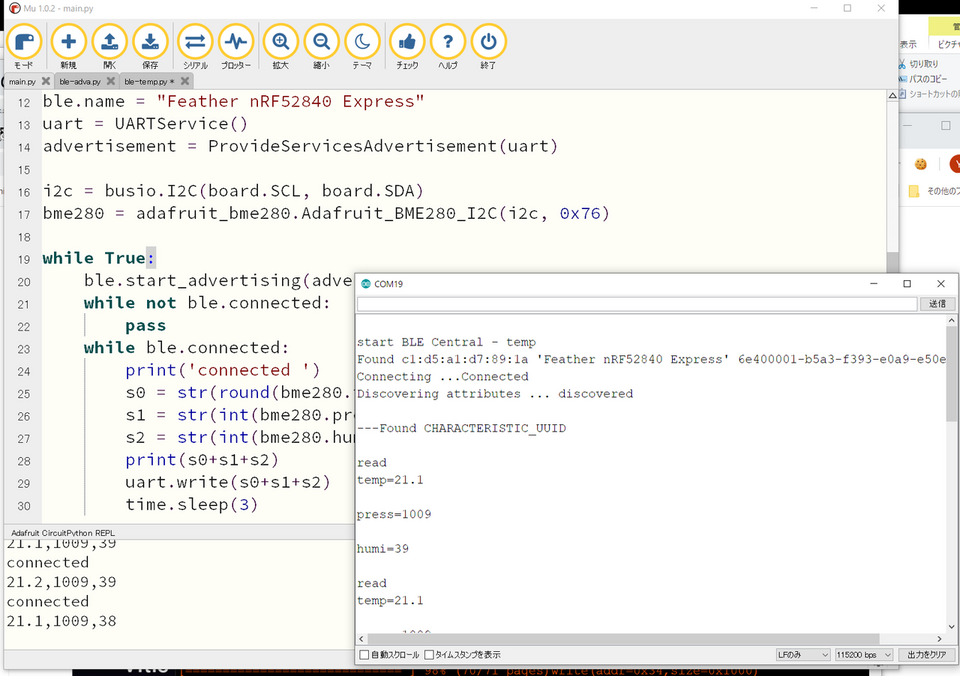初めてのBLE (19) CircuitPythonでペリフェラル③ BME280
この連載の一連の実験と同様に、MEMSセンサのBME280をマイコン・ボードFeather nRF52840 Expressに取り付けて、温度、気圧、湿度を送れるようにします。CircuitPythonのプログラムではUARTサービスを利用しているので、テキストで、三つのデータを送ることにします。
●BME280をつなぐ
今までと同様にI2Cでつなぎます。入手したボードでは、スレーブ・アドレスが0x76に設定されています。
| BME280 | Feather nRF52840 Express |
|---|---|
| Vcc | 3V(3.3V) |
| GND | GND |
| SCL | SCL |
| SDA | SDA |
●BME280の動作確認
examplesに入っているbme280_simpletest.pyを読み込みます。1か所スレーブ・アドレスを変更します。
bme280 = adafruit_bme280.Adafruit_BME280_I2C(i2c,0x76)
保存して実行します。
必要な場所だけ残します。
import time
import board
import busio
import adafruit_bme280
i2c = busio.I2C(board.SCL, board.SDA)
bme280 = adafruit_bme280.Adafruit_BME280_I2C(i2c,0x76)
while True:
print(bme280.temperature, bme280.pressure, bme280.humidity)
time.sleep(2)
●ペリフェラル
ペリフェラルは、Feather nRF52840 Expressで作ります。
第17回の温度のプログラムと上記のプログラムを合体します。write()内で'xxxx'のような文字なら長くても送れるのですが、三つの測定値をstr()で変換して送ろうとすると、エラーが出たり、送られたデータが意味不明だったりしました。
温度は小数点第一位、気圧と湿度は整数にしました。センサの確度から言えば、適正だと思います。三つの数値はカンマで区切りましたが、コロンでも、あとで分離しやすい文字であればよいです。
import time
from adafruit_ble import BLERadio
from adafruit_ble.advertising.standard import ProvideServicesAdvertisement
from adafruit_ble.services.nordic import UARTService
import board
import busio
import adafruit_bme280
ble = BLERadio()
ble.name = "Feather nRF52840 Express"
uart = UARTService()
advertisement = ProvideServicesAdvertisement(uart)
i2c = busio.I2C(board.SCL, board.SDA)
bme280 = adafruit_bme280.Adafruit_BME280_I2C(i2c, 0x76)
while True:
ble.start_advertising(advertisement)
while not ble.connected:
pass
while ble.connected:
print('connected ')
s0 = str(round(bme280.temperature,1)) + ','
s1 = str(int(bme280.pressure)) + ','
s2 = str(int(bme280.humidity))
print(s0+s1+s2)
uart.write(s0+s1+s2)
time.sleep(3)
RSL10 Bluetooth Low Enaergy Exploerからつなぎました。想定通りのセンサ値が送られていることが確認できました。
●セントラル
NANO 33 BLE senseでセントラルを動かします。第16回のスケッチをベースに修正します。
93行で、変数dataにキャラUART(RX)から文字データを取り込みます。97~104行では、最初のカンマを見つけ、そこまでの文字(温度)を取り出します。106~113行では、温度の文字を削り、カンマを見つけ、気圧の文字を取り出します。最後の115~117行は、気圧の文字を削れば、残った文字が湿度になります。
#include <ArduinoBLE.h>
#define SERVICE_UUID "6e400001-b5a3-f393-e0a9-e50e24dcca9e" // UART
#define characteristicTxUUID "6e400002-b5a3-f393-e0a9-e50e24dcca9e" // Tx
#define characteristicRxUUID "6e400003-b5a3-f393-e0a9-e50e24dcca9e" // Rx
#define localNAME "Feather nRF52840 Express"
void setup() {
Serial.begin(9600);
while (!Serial);
BLE.begin();
Serial.println("\nstart BLE Central - BME280-UART");
// start scanning for peripherals
BLE.scanForName(localNAME);
}
void loop() {
// check if a peripheral has been discovered
BLEDevice peripheral = BLE.available();
if (peripheral) {
// discovered a peripheral, print out address, local name, and advertised service
Serial.print("Found ");
Serial.print(peripheral.address());
Serial.print(" '");
Serial.print(peripheral.localName());
Serial.print("' ");
Serial.print(peripheral.advertisedServiceUuid());
Serial.println();
if (peripheral.localName() != localNAME) {
return;
}
// stop scanning
BLE.stopScan();
readUARTdata(peripheral);
// peripheral disconnected, start scanning again
BLE.scanForName(localNAME);
}
}
void readUARTdata(BLEDevice peripheral) {
// connect to the peripheral
Serial.print("Connecting ...");
if (peripheral.connect()) {
Serial.println("Connected");
} else {
Serial.println("Failed to connect!");
return;
}
// discover peripheral attributes
Serial.print("Discovering attributes ...");
if (peripheral.discoverAttributes()) {
Serial.println(" discovered\n");
} else {
Serial.println("Attribute discovery failed!");
peripheral.disconnect();
return;
}
// retrieve the LED characteristic
BLECharacteristic UARTCharacteristic = peripheral.characteristic(characteristicRxUUID);
if (!UARTCharacteristic) {
Serial.println("Peripheral does not have UART characteristic!");
peripheral.disconnect();
return;
}
Serial.println("---Found CHARACTERISTIC_UUID");
while (peripheral.connected()) {
// Serial.println("connected");
if (UARTCharacteristic.canRead()) { // start Notify?
Serial.println("canread");
} else {
// Serial.println("error reading characteristic value");
// read the characteristic value
UARTCharacteristic.read();
Serial.print("\nread ");
if (UARTCharacteristic.valueLength() > 0) {
// Serial.print("length= ");Serial.println(UARTCharacteristic.valueLength());
String data = "";
int i =0;
int l = UARTCharacteristic.valueLength();
while (l > 0) {
l = l -1;
data.concat(((char)*(UARTCharacteristic.value()+i)));
// Serial.print("i= ");Serial.print(i);Serial.print(" ");Serial.println((char)data);
i += 1;
}
byte buf[]="";
Serial.println(data);
//Serial.println(data.indexOf(","));
data.getBytes(buf, data.indexOf(",")+1);
Serial.print("\ntemp=");
for (int k=0; k<=(data.indexOf(",")) ; k++){
Serial.print((char)buf[k]);
}
Serial.println();
data = data.substring(data.indexOf(",")+1);
//Serial.println(data);
byte buf2[]="";
data.getBytes(buf2, data.indexOf(",")+1);
Serial.print("\npress=");
for (int k=0; k<=(data.indexOf(",")) ; k++){
Serial.print((char)buf2[k]);
}
Serial.println();
data = data.substring(data.indexOf(",")+1);
Serial.print("\nhumi=");
Serial.println(data);
delay(5000);
}
}
}
Serial.println("Peripheral disconnected");
}
実行している様子です。送ったデータが、そのまま表示できました。


